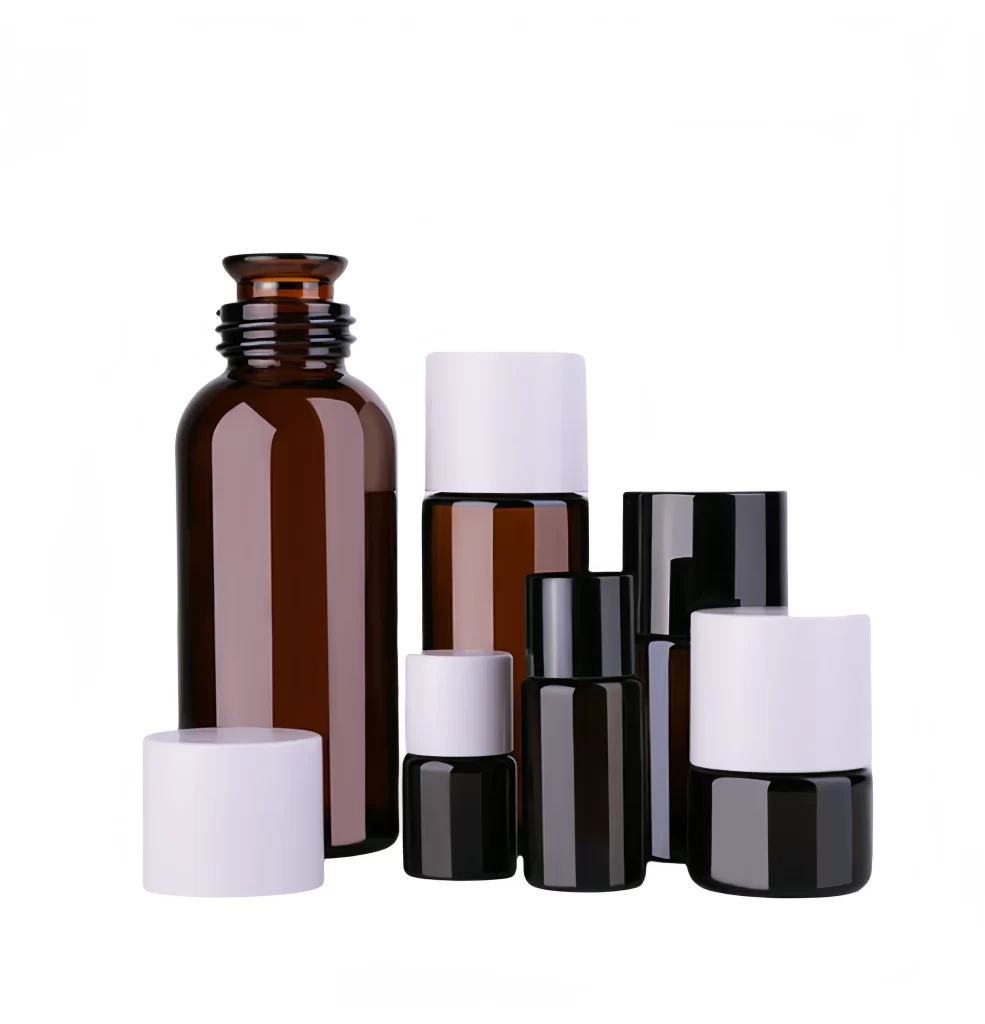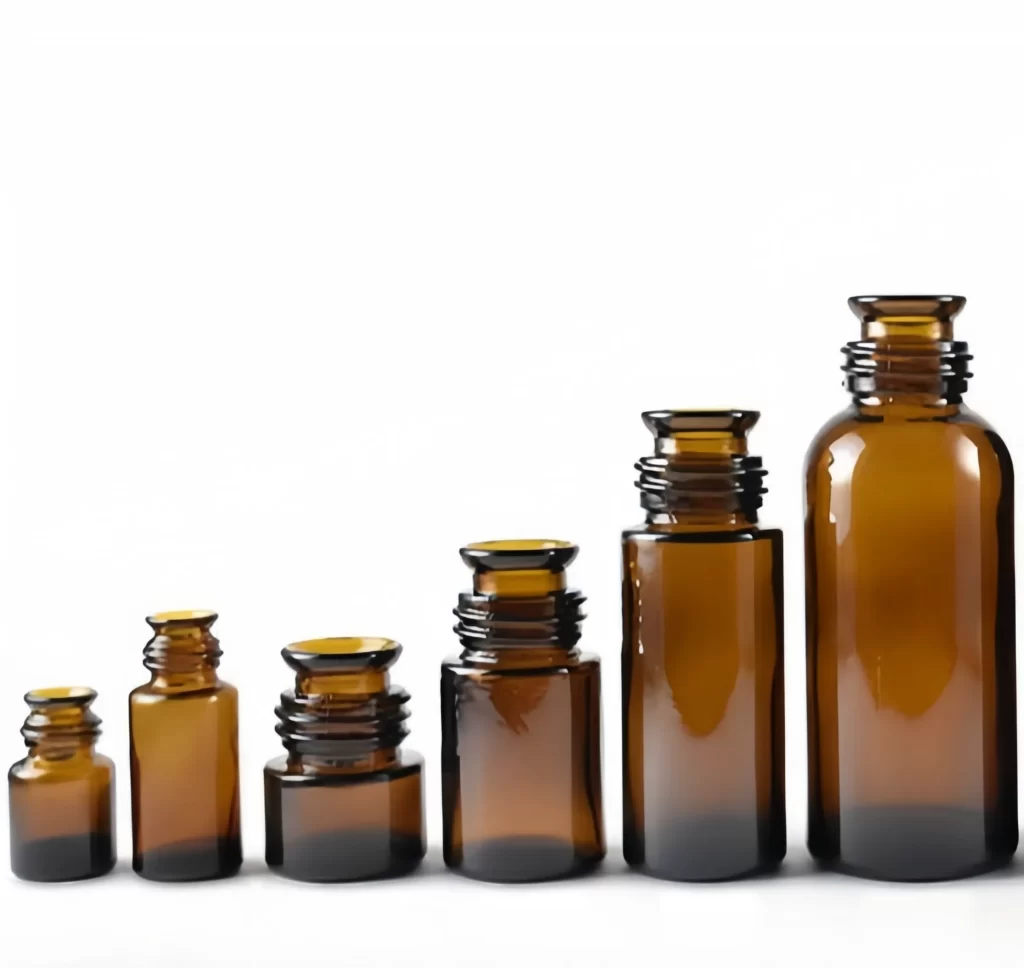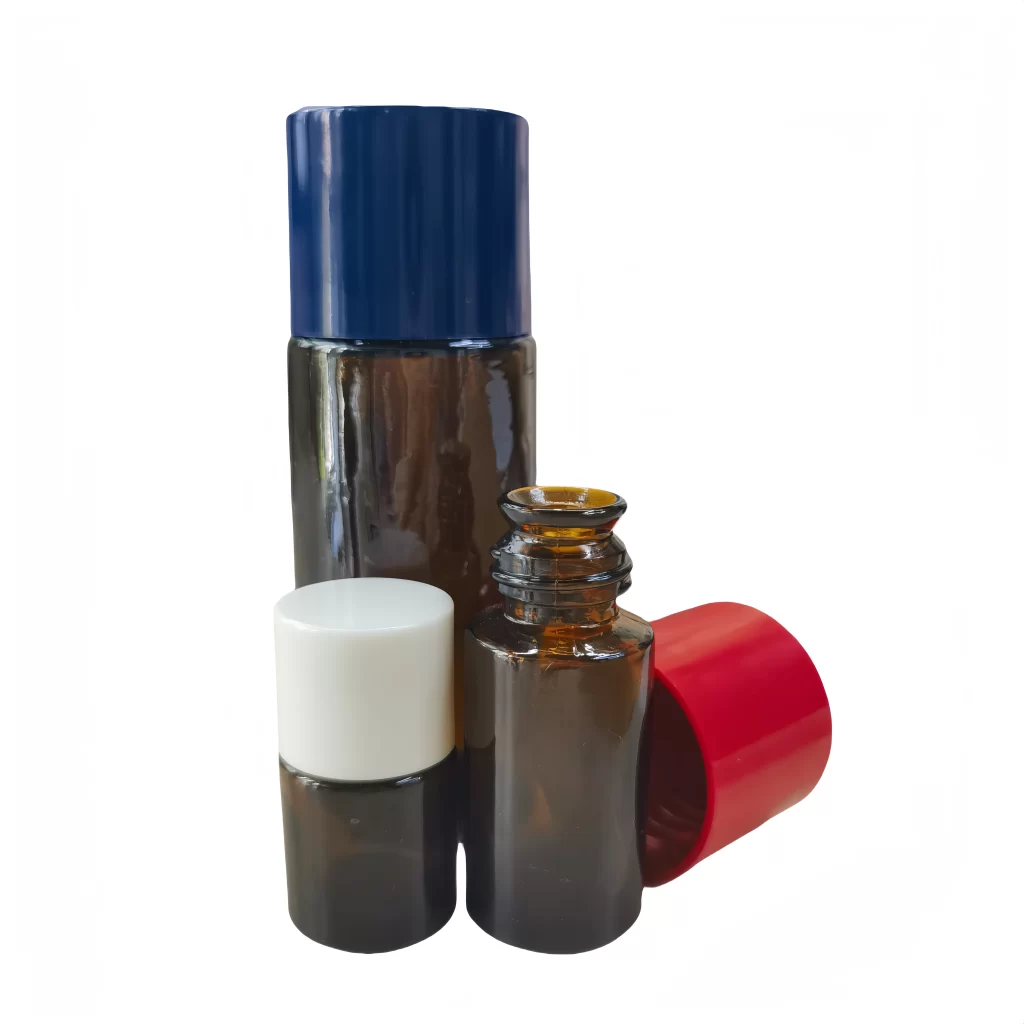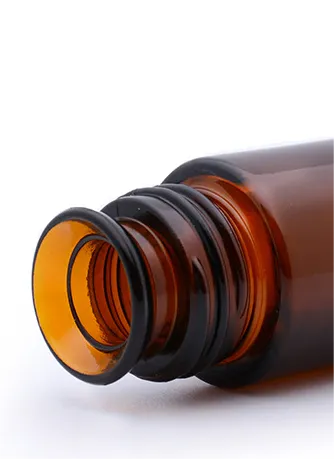Pour-Out Glass Bottles | Design, Applications, and Sustainability
Pour-out round glass bottles are the most commonly used and important packaging form in the packaging industry today. Its unique design and versatility make it a packaging choice in the fields of food, medicine, beauty, and more.
This article aims to explore various aspects of pour out round glass bottles. Through a comprehensive analysis of many aspects, we will better understand the importance of inverted circular glass bottles(pour out round glass bottles) in the modern packaging industry and explore their role in promoting product quality, enhancing user experience, and protecting the environment.
☛ Preamble
The inverted circular glass bottle has good sealing, durability, and aesthetics, and is widely used in multiple industries such as food, medicine, and beauty. Its advantages in protecting product quality, improving user convenience, and displaying effects make it the preferred packaging form for many brands.
☛ Design Principle of Inverted Circular Glass Bottle
-
-
Basic Structure and Construction
-
The bottle body is usually designed in a circular shape to ensure stability and uniform liquid or solid flow. The material of the bottle body is made of high transparency glass, which can clearly observe the situation inside the bottle whether it is transparent, colorless, amber, or black. The wall thickness of the bottle body is uniform, and the durability and compression resistance of the glass bottle are greatly improved.
Bottlenecks are usually designed with spiral patterns, easy to install necks, or smooth ports that can adapt to other types of sealing caps, making it easy to install sealing caps and also controlling the flow rate of contents poured out.
The bottom of the bottle is usually designed as a thicker base to enhance the stability of the pour out round glass bottle itself and prevent tipping. Part of the bottle bottom adopts a concave design, which enhances the impact resistance of the glass bottle and reduces friction with the contact surface.
-
-
Material Selection and Characteristics
-
Pour out round glass bottles are usually made of glass material, usually reinforced glass or pharmaceutical grade glass. Glass material has certain chemical stability and does not react with most chemicals, ensuring the purity and safety of the liquid in the bottle. The high transparency of glass also allows users to easily check the status of the liquid inside the bottle. This material has high resistance to temperature changes and is not easily deformed or cracked. Moreover, as a recyclable material, glass meets environmental requirements and helps to reduce environmental pollution.
Many pharmaceutical grade glass and reinforced glass have higher impact resistance, which can greatly reduce the risk of damage. Even if they break, they can cause minimal harm to people or other objects to a large extent.
-
-
Process Technology and Manufacturing Process
-
Blowing Process: By utilizing the constraints of mold forming, the molten glass is blown into shape by blowing to ensure uniform thickness and standardized shape of the bottle body; Some high-end glass products are made using free blow molding technology and handcrafted by craftsmen, so each bottle has its own unique characteristics.
Heat Treatment: After the glass bottle is made, it needs to undergo annealing treatment. The temperature of the glass bottle gradually cools to eliminate internal stress, enhance the stability and durability of the bottle. Then, the glass bottle body is strengthened through physical and chemical methods to improve its impact and compressive strength.

Surface Treatment: After the glass bottle body is formed, a film is coated on the glass surface to enhance the wear resistance of the bottle and even serve as a decorative effect. For our pour out round glass bottles, we can provide customized services such as customized printing and engraving. We can also use customized hot stamping, silver stamping, etc. according to customer needs. We can also use printing and engraving techniques to add brand identification and product information to the bottle body, improving brand recognition and aesthetics.
The design of pour out round glass bottles emphasizes the rationality of the structure and the high-quality selection of materials. Through advanced and precise manufacturing processes and technologies, it ensures its convenience and safety during use. This design and practicality of the pour out glass bottle have a wide range of applications and a good user experience in multiple industries.
☛ The Application Fields and Scenarios of Pour-out Round Glass Bottle
Pour-out round glass bottles have a wide range of applications in food, medicine, beauty, and other fields due to their superior functionality and aesthetics.
-
-
Food Industry
-
Pour out round glass bottles are commonly used for packaging edible oils, condiments, and even beverage packaging. The transparent proportion of the bottle body can fully display the quality of the oil, and the wide mouth bottleneck helps to control the pouring amount; The colored glass bottle body can also protect foods such as oils and beverages from the influence of sunlight and air.
-
-
Medicine and Cosmetics
-
Medicine Packaging: such as oral liquids, the inverted circular glass bottle ensures the purity and safety of the drug, and the glass material is not easy to react with drugs and other chemicals. As a container for laboratory reagents, it is also suitable for the storage and distribution of chemical reagents, under the premise of safe storage, and can ensure the accuracy of experimental data.
Pour out round glass bottles are also suitable for perfume packaging. Its transparency and beauty improve the product’s grade while providing a pleasing experience. Glass packaging can effectively protect and retain perfume to the greatest extent. The inverted design helps users control their dosage during use, effectively avoiding waste and pollution. At the same time, glass bottles can effectively preserve the active ingredients of essential oils and beauty solutions.
-
-
Use Cases in Other Fields
-
In terms of household daily necessities, pour out round glass bottles can be used to hold household detergents and cleaners, ensuring hygiene and safety during use. Some home decorations, such as handmade aromatherapy bottles and essential oil bottles, can also adopt this design, which is both practical and beautiful.
☛ Analysis of Advantages and Shortcomings of Pour-out Glass Bottles
-
-
Advantsges
-
Chemical Stability: Glass materials have excellent chemical stability and are not prone to chemical reactions with the contents, ensuring the purity and safety of the contents. Secondly, the stability of this product is not only reflected in its chemical properties, but also in its ability to withstand high and low temperatures in the external environment. It is not easily deformed or ruptured and is suitable for various storage conditions.
High Transparency: The high transparency of glass allows users to observe the contents of the bottle more clearly, making it easier to check the status and remaining amount of the contents.
Elegant Appearance: This glass bottle has a different appearance from ordinary glass bottles. It has a beautiful appearance and helps to improve the image of the product and brand, especially in the high-end food and beauty industries.
Sustainability and Environmental Impact: Glass is a material that can be 100% recycled after treatment. After complete cleaning, it can be processed countless times and reused to reduce resource waste and minimize environmental pollution.
Long Term Service Life: The durability of glass bottles represents their ability to be reused multiple times, reducing the need for disposable packaging and greatly reducing the generation of waste.
Decomposition Time: Although glass has a longer decomposition time in the natural environment (some can reach thousands of years), its stable physical and chemical properties make recycling a more environmentally friendly choice.
-
-
Are Pour-out Glass Bottle More Hygienic Than Plastic?
-
Non Porous Surface: The surface of glass is smooth and non porous, making it less prone to bacterial growth. Compared to plastic materials, it is easier to clean and disinfect.
No Chemical Leakage: Glass does not release harmful substances to the human body (such as bisphenol A) when exposed to high temperatures like some plastics, making it safer and more hygienic when storing food and drugs.
Corrosion Resistance: Glass material is not easily corroded by extreme chemicals such as acid and alkali, and can maintain the quality of the liquid in the bottle for a long time.
-
-
Shortcomings
-
Fragility: Glass materials are relatively fragile compared to plastics and other materials, and are prone to breakage during transportation, storage, and use. They require careful handling and protection, which increases the cost of use and storage.
Weight Issue: Compared to other lightweight materials such as plastic, glass bottles have a relatively heavy self weight, which invisibly increases costs and carbon emissions throughout the entire production and use process, which is not conducive to improving portability and transportation efficiency.
High Manufacturing Cost: The manufacturing process of glass bottles is complex and costly, which may lead to an increase in product pricing and affect the final selling price, which is not conducive to large-scale low-cost applications.
The Complexity of the Recycling Process: As a recyclable material, the recycling and reprocessing process of glass requires high energy consumption and technology, especially for glass with different colors and materials that need to be classified and processed, which to some extent increases the difficulty and cost of recycling.
Pour out round glass bottles have significant advantages in many aspects, including excellent chemical stability, high transparency, strong practicality, high durability, hygiene, and recyclability. However, its fragility, high weight, and high manufacturing and recycling costs are also factors to consider when choosing pour out round glass bottles. However, overall, glass bottles still hold a crucial position in high-end products and environmentally friendly applications.
☛ Maintenance & Isinfection, and Recycling of Pour-out Round Glass Bottles
-
-
Maintenance
-
-
- Daily Cleaning: When using warm water and mild detergent for daily cleaning of pour out round glass bottles, it is recommended to use warm sleeping or mild detergent. Avoid using cleaning products containing irritating substances or abrasives to avoid scratching the surface and interior of the glass bottle. Avoid placing glass bottles in severe temperature differences and avoid sudden cooling and heating during cleaning. Similarly, use a soft cloth or sponge to wipe the bottle body and avoid using a metal brush or steel wire ball to rub against the glass bottle.
- Storage: After cleaning, it is necessary to thoroughly air dry to avoid water residue in the bottle to prevent the growth of bacteria and mold. To avoid collision, the bottle bodies should avoid colliding with each other during storage. Soft partitions or gaskets can be used for isolation to prevent damage.
-
-
Disinfect
-
-
- High Temperature Disinfection: Boiling disinfection, placing glass bottles in boiling water for about 5-10 minutes, can effectively kill most bacteria and viruses, suitable for disinfection of food and drug packaging bottles. Similarly, oven disinfection can be used by placing glass bottles in an oven at 160-180 degrees Celsius and heating continuously for 20-30 minutes. This method is suitable for disinfecting most small household items.
- Chemical Disinfection: Use a solution with an alcohol concentration of 70% to wipe the inner and outer surfaces of the bottle, allowing the alcohol to stay on the surface for sufficient time to effectively kill bacteria. Wait until the alcohol is completely evaporated before using the glass bottle. Soak the glass bottle in disinfectant solution, using an appropriate amount of diluted food grade disinfectant. After soaking, rinse thoroughly with clean water.
-
-
Recycling and Disposal Methods for Discarded Pour-out Glass Bottles
-
-
- Classification and Recycling: Classifying glass bottles by color can help improve the efficiency and quality of recycling, as different colored glasses are treated differently during the recycling process. Clean and remove labels. Before recycling, the glass bottle should be thoroughly cleaned to remove labels and adhesive from the bottle body, in order to reduce the hassle of the recycling process.
- Send to Recycling Center: Send discarded glass bottles to local glass recycling points or stations, which usually have dedicated glass recycling facilities. Participate in community recycling projects. Many communities or cities have glass recycling projects, and users can regularly place discarded glass bottles in designated recycling bins for disposal by specialized recycling companies.
- Reuse: For creative purposes in households, discarded glass bottles can also be reused for home decoration, vases, storage jars, etc., to extend their service life. DIY collection project, using discarded glass bottles for various DIY handicraft projects, such as making lampshades, candle holders, etc., to turn waste into treasure.
-
-
Glass Decomposition Time
-
Glass, as a very stable packaging material, naturally decomposes for a very long time. It is estimated that glass takes thousands of years or even longer to fully decompose in the natural environment. Therefore, the recycling and reuse of glass bottles is crucial for environmental protection. By using scientific and reasonable methods to recycle and reuse them, the negative impact on the environment can be significantly reduced.
Proper maintenance and disinfection of pour out glass bottles can help extend their service life; Maintaining cleanliness and hygiene during use and effective recycling after disposal can not only reduce environmental pollution but also achieve sustainable utilization of resources. Although glass has an extremely long decomposition time in the natural environment, the impact of glass bottles on the environment can be greatly reduced through scientific recycling and reuse.
☛ Design and Innovation
-
-
Improvement and Innovation of Existing Designs
-
-
- Optimization of Bottle Mouth Design: Introducing more powerful leak prevention functions can also be used to design and manufacture related derivative glass containers, such as containers with flow control valves or self sealing caps, to improve convenience and safety of use, enhance the control accuracy and leak prevention effect of pouring.
- Material Improvement: Developing and manufacturing lighter glass materials to reduce the weight of bottles while maintaining strength, lowering transportation costs, and reducing carbon emissions during the process. Alternatively, chemical or physical methods can be used to enhance the impact resistance and durability of glass, in order to reduce the risk of glass bottle breakage.
- Innovation in Bottle Body Design: Optimize the shape of the bottle body to make it more in line with people’s daily grip habits and ergonomic design; It is also possible to design bottle bodies with measurement scales or multi-purpose to increase the functionality of the product.
- Environmental Design: Explore the use of some harmful materials such as glass or mixed materials to improve overall environmental performance. Design detachable labels for easy cleaning and recycling.
-
-
Possible Future Development Trends
-
-
- Personalized Customization: In the future, we will provide users with more personalized customization services and options, customize the color, shape, and printing of the bottle body according to customer needs, and meet the personalized needs of the brand and consumers.
- Green Manufacturing Technology: adopting low-carbon manufacturing processes, low energy consumption, and low emissions manufacturing processes, reducing the carbon footprint of the entire product production line. A closed-loop recycling system can also be established to ensure the sustainability and resource reuse of the entire process from production to use and recycling of glass bottles.
- Multi Functional Design: Design modular glass bottles that can be smoother with different functions and shapes of bottle mouths or accessories as needed, achieving versatility for one bottle; More creative glass bottle designs can be developed, such as double-layer glass bottles, where the inner layer can be used to store liquids and the outer layer provides insulation or decorative functions to enhance the user experience.
Pour out round glass bottles have broad development prospects in design and innovation. By optimizing existing designs and introducing new technologies, their functionality, convenience, and environmental performance can be greatly improved. The future development trends may include personalized customization, green manufacturing, and multifunctional design. These innovative trends will further meet market demand and promote the sustainable development of the packaging industry in the future.
☛ Conclusion
Pour out round glass bottles have irreplaceable excellent design and versatile development, and have been widely used in various industries. Its outstanding unique characteristics are loved and trusted by users. In the future, pour out glass bottles will still face innovation and challenges to meet the dual goals of constantly changing market demands and environmental protection. The industry can also actively explore the development trends of products to promote continuous progress in products and markets.

 Italiano
Italiano Português
Português



Your point of view caught my eye and was very interesting. Thanks. I have a question for you.
Thank you, please continue to follow and welcome any questions
Your article helped me a lot, is there any more related content? Thanks!
Thank you very much for reading our article, read all of our articles: https://www.yf-pak.com/blog/.
Thanks for sharing. I read many of your blog posts, cool, your blog is very good.
Thanks for sharing. I read many of your blog posts, cool, your blog is very good.
Thank you.
Your article helped me a lot, is there any more related content? Thanks!
Muchas gracias. ?Como puedo iniciar sesion?